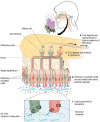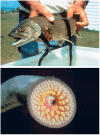The scent of life. The exquisite complexity of the sense of smell in animals and humans - PubMed (original) (raw)
Review
The scent of life. The exquisite complexity of the sense of smell in animals and humans
Andrea Rinaldi. EMBO Rep. 2007 Jul.
No abstract available
Figures
Figure 1
The human olfactory system. The odorant receptors are localized on olfactory sensory neurons, which occupy a small area in the upper part of the nasal epithelium. Every olfactory receptor cell expresses only one odorant receptor. On activation, signals from olfactory receptor cells are relayed in the glomeruli—well defined micro-regions in the olfactory bulb. Receptor cells of the same type are randomly distributed in the nasal mucosa but converge on the same glomerulus. In the glomerulus, the receptor nerve endings excite mitral cells that forward the signal to higher regions of the brain. Credit: Karolinska Institutet and Nobel Foundation, Stockholm, Sweden.
Figure 2
CO2-sensitive neurons expressing Gr21a (green) and Gr63a (red), proteins that together are necessary for CO2 detection in Drosophila. The neurons target a specific region of the fly brain, which is dedicated to processing the smell of CO2. Credit: Vosshall Laboratory, Rockefeller University. Reprinted with permission from Macmillian Publishers Ltd [Nature, Jones et al, 2007].
Figure 3
Sea Lamprey (Petromyzon marinus) on lake trout (top) and detail of the oral disc (bottom). Sea lampreys are found in the Great Lakes region and injure lake trout and many other fishes, from which they suck out the body fluids by using teeth and a grasping tongue. Credit: US Fish and Wildlife Service.
Similar articles
- Neuroscience: the sweet smell of success.
Dennis C. Dennis C. Nature. 2004 Mar 25;428(6981):362-4. doi: 10.1038/428362a. Nature. 2004. PMID: 15042058 No abstract available. - The secret codes of mammalian scents.
Ferrero DM, Liberles SD. Ferrero DM, et al. Wiley Interdiscip Rev Syst Biol Med. 2010 Jan-Feb;2(1):23-33. doi: 10.1002/wsbm.39. Wiley Interdiscip Rev Syst Biol Med. 2010. PMID: 20836008 Review. - Olfactory receptors and odor coding in mammals.
Buck LB. Buck LB. Nutr Rev. 2004 Nov;62(11 Pt 2):S184-8; discussion S224-41. doi: 10.1111/j.1753-4887.2004.tb00097.x. Nutr Rev. 2004. PMID: 15630933 Review. - Olfactory signalling in vertebrates and insects: differences and commonalities.
Kaupp UB. Kaupp UB. Nat Rev Neurosci. 2010 Mar;11(3):188-200. doi: 10.1038/nrn2789. Epub 2010 Feb 10. Nat Rev Neurosci. 2010. PMID: 20145624 Review. - [The human olfactory system. Anatomy and physiology].
Albrecht J, Wiesmann M. Albrecht J, et al. Nervenarzt. 2006 Aug;77(8):931-9. doi: 10.1007/s00115-006-2121-z. Nervenarzt. 2006. PMID: 16871378 Review. German.
Cited by
- How to nudge students toward healthier snacks? Consumer neuroscience insights on multisensory nudge interventions in university vending machines.
Casiraghi C, Chiarelli S, Gifuni G, Fici A, Bilucaglia M, Jacomuzzi AC, Micheletto V, Zito M, Russo V. Casiraghi C, et al. PLoS One. 2025 Jun 26;20(6):e0325804. doi: 10.1371/journal.pone.0325804. eCollection 2025. PLoS One. 2025. PMID: 40569907 Free PMC article. - Analysis of single-cell transcriptomes links enrichment of olfactory receptors with cancer cell differentiation status and prognosis.
Kalra S, Mittal A, Gupta K, Singhal V, Gupta A, Mishra T, Naidu S, Sengupta D, Ahuja G. Kalra S, et al. Commun Biol. 2020 Sep 11;3(1):506. doi: 10.1038/s42003-020-01232-5. Commun Biol. 2020. PMID: 32917933 Free PMC article. - COVID-19 Induced Taste Dysfunction and Recovery: Association with Smell Dysfunction and Oral Health Behaviour.
Catton G, Gardner A. Catton G, et al. Medicina (Kaunas). 2022 May 26;58(6):715. doi: 10.3390/medicina58060715. Medicina (Kaunas). 2022. PMID: 35743978 Free PMC article. - Histological, chemical and behavioural evidence of pedal communication in brown bears.
Sergiel A, Naves J, Kujawski P, Maślak R, Serwa E, Ramos D, Fernández-Gil A, Revilla E, Zwijacz-Kozica T, Zięba F, Painer J, Selva N. Sergiel A, et al. Sci Rep. 2017 Apr 21;7(1):1052. doi: 10.1038/s41598-017-01136-1. Sci Rep. 2017. PMID: 28432322 Free PMC article.
References
- Brookes JC, Hartoutsiou F, Horsfield AP, Stoneham AM (2007) Could humans recognize odor by phonon assisted tunnelling? Phys Rev Lett 98: doi:10.1103/PhysRevLett.98.038101 - PubMed
- Burr C (2003) The Emperor of Scent: A Story of Perfume, Obsession, and the Last Mystery of the Senses. New York, NY, USA: Random House
- Jones WD, Cayirlioglu P, Kadow IG, Vosshall LB (2007) Two chemosensory receptors together mediate carbon dioxide detection in Drosophila. Nature 445: 86–90 - PubMed
- Keller A, Vosshall LB (2004) A psychophysical test of the vibration theory of olfaction. Nat Neurosci 7: 337–338 - PubMed
Publication types
MeSH terms
Substances
LinkOut - more resources
Full Text Sources
Other Literature Sources


